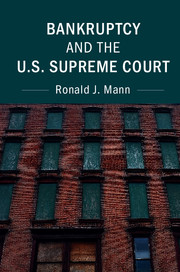Book contents
- Frontmatter
- Contents
- List of Figures
- List of Tables
- Preface
- Introduction
- PART I SETTING THE STAGE
- PART II THE HARD CASES
- SECTION A MISSED OPPORTUNITIES: CONGRESS, THE COURT, AND THE BANKRUPTCY CLAUSE
- SECTION B INTERPRETIVE STRATEGY: THE COURT, THE SOLICITOR GENERAL, AND THE CODE
- 7 Bankruptcy versus Labor Law: Bildisco
- 8 Bankruptcy versus Environmental Law: MidLantic
- 9 Bankruptcy versus Criminal Law: Kelly
- 10 Setting Text against Tradition: Ron Pair
- 11 Bankruptcy and State Sovereignty: BFP
- PART III AMICI AND THE COURT
- PART IV CONCLUSION
7 - Bankruptcy versus Labor Law: Bildisco
from SECTION B - INTERPRETIVE STRATEGY: THE COURT, THE SOLICITOR GENERAL, AND THE CODE
Published online by Cambridge University Press: 04 May 2017
- Frontmatter
- Contents
- List of Figures
- List of Tables
- Preface
- Introduction
- PART I SETTING THE STAGE
- PART II THE HARD CASES
- SECTION A MISSED OPPORTUNITIES: CONGRESS, THE COURT, AND THE BANKRUPTCY CLAUSE
- SECTION B INTERPRETIVE STRATEGY: THE COURT, THE SOLICITOR GENERAL, AND THE CODE
- 7 Bankruptcy versus Labor Law: Bildisco
- 8 Bankruptcy versus Environmental Law: MidLantic
- 9 Bankruptcy versus Criminal Law: Kelly
- 10 Setting Text against Tradition: Ron Pair
- 11 Bankruptcy and State Sovereignty: BFP
- PART III AMICI AND THE COURT
- PART IV CONCLUSION
Summary
The Supreme Court got its first chance to interpret the Bankruptcy Code quickly – NLRB v. Bildisco reached the Court less than six months after the decision in Marathon. The case is interesting not only because it gave the Court its first look at the substance of the new Code, but because the divided opinions in that case sowed the seeds of what would ripen over time into a consistent practice in the statutory context that parallels what we have discussed above in the constitutional context: at every opportunity for reasonable disagreement, subordinating the interests of the bankruptcy process to competing state and federal interests.
The case is a good one for our analysis, because it presents a direct conflict between the new Bankruptcy Code and another of the major loci of federal policy – labor law. Looking ahead to the features of the cases considered in the chapters to come, it also is fair to say that several overlapping characteristics made Bildisco the hardest case for ruling against the bankruptcy interest. First, the relevant bankruptcy power (limiting collective bargaining agreements) was well established under the Act (something that will not be true in the later chapters). Second, the framework under the Code if anything broadened the bankruptcy court's power as compared to the Act. Third, the Solicitor General's ability to make a strong presentation against the bankruptcy interest was hampered by the Solicitor General's obvious bias toward its client, the NLRB. Finally, and perhaps most importantly, the case arose at a time when a large group of the Justices, for reasons wholly unrelated to the bankruptcy process, were concerned about excessive over breadth of the labor power.
So how does it turn out? With all of those features weighing in favor of the bankruptcy side, the Court elevated the bankruptcy interest over the labor interest, albeit only by a 5–4 vote, and only after last-minute negotiations that came close to gutting the Court's stance on the case's most important issue.
INTRODUCTION
During the height of the 1980s recession, a small New Jersey partnership filed for bankruptcy and sought to set aside a labor agreement with its employees. The company, Bildisco, was in the business of distributing building supplies; it employed eighteen workers. By most measures, the bankruptcy was unremarkable – the case involved neither millions of dollars nor the prospect of economy-wrenching unemployment.
- Type
- Chapter
- Information
- Bankruptcy and the U.S. Supreme Court , pp. 99 - 124Publisher: Cambridge University PressPrint publication year: 2017

